Amidst the diversity that threads through India’s cultural tapestry, it’s staggering to find that a single state, Rajasthan, is home to a community known for hosting weddings that are nothing short of a royal affair, with each ceremony taking on an almost cinematic grandeur. A Guide to Marwari Wedding Rituals & Traditions.
Marwari wedding ceremonies are renowned for blending opulence with deep-rooted marwari marriage traditions, resulting in a unique celebration of love and unity that often spans several days. As connoisseurs of these vibrant nuptials, we are thrilled to unveil a guide to Marwari wedding rituals & traditions, offering an insider look into the symphony of customs that comprise a Marwari matrimonial extravaganza.
Our exploration dives into the heart of these elaborate celebrations, where every detail is steeped in significance, from the ceremonial preludes to the concluding rites. Through this guide, we not only invite you to witness the visual spectacle but also to understand the profound cultural nuances that uphold the sanctity and joy of the matrimonial bond. In doing so, we hope to provide a catalog of the age-old traditions that lend Marwari weddings their distinctive splendor and emotional resonance, fostering an appreciation for the art of marrying the way Marwaris do.
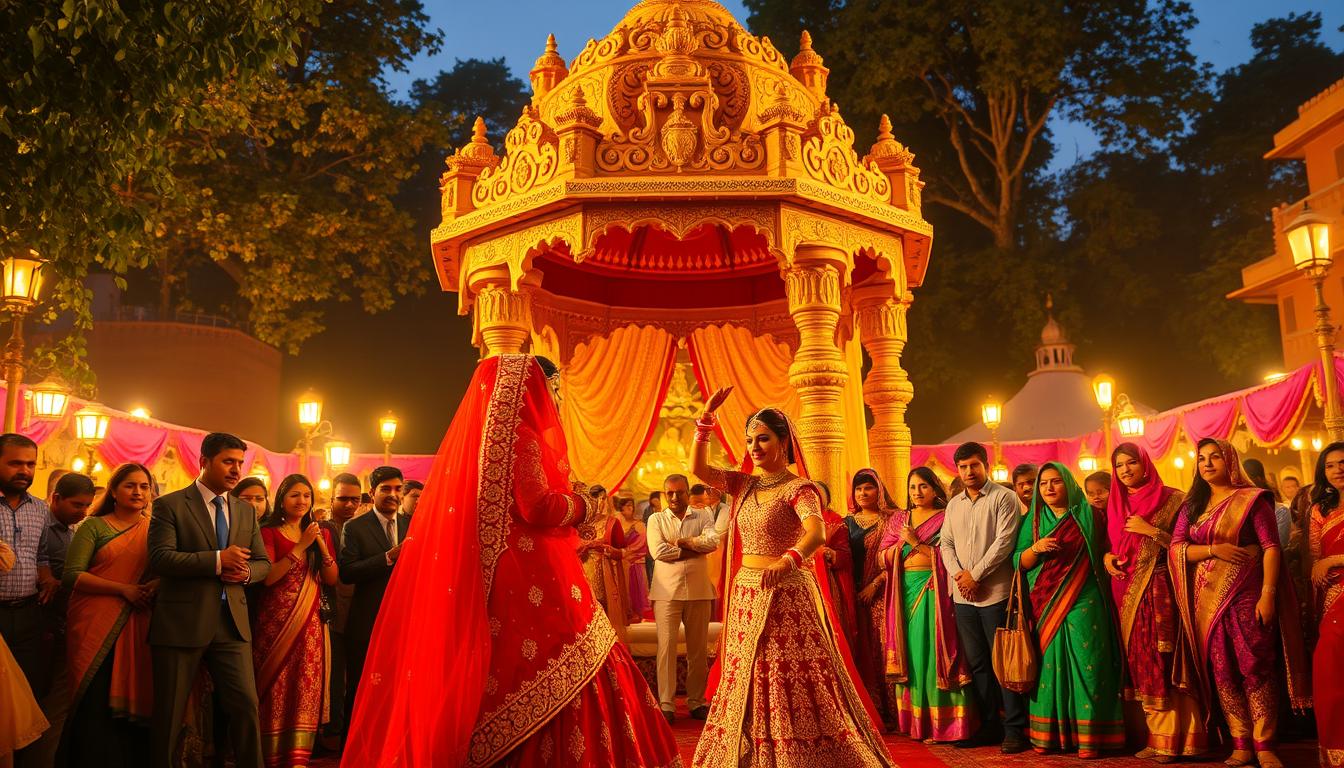
Key Takeaways
- Discover the rich tapestry of a Marwari wedding ceremony, celebrated with grandeur and cultural pride.
- Gain insight into the marwari marriage traditions, which have been preserved and cherished over generations.
- Understand the role of each custom with our guide to Marwari wedding rituals & traditions.
- Appreciate the union of two families as well as two souls in a Marwari marriage.
- Explore the deep cultural roots and vibrant expressions that make these weddings a truly memorable affair.
Understanding Marwari Wedding Customs
As we delve into the intricacies of Marwari wedding customs, it’s crucial to appreciate the cultural depth that these traditions hold. Marwari cultural wedding practices aren’t just about the vibrant celebrations; they embody a rich tapestry of history, honor, and spirituality that is woven into the life of every Marwari couple.
Significance of Marwari Culture in Weddings
Marwari culture is renowned for its strong community ties and religious fervor, which play a pivotal role in wedding ceremonies. Every ritual is steeped in symbolic meanings, designed to bless the new couple with prosperity, happiness, and longevity. Understanding these customs provides insight into the core values that Marwari families cherish and uphold.
Pre-Wedding Rituals Overview
The journey to a Marwari wedding begins long before the actual day. Pre-wedding rituals such as the ‘Sagan’ and ‘Mehfils’ set the stage for the union, facilitating not just the bonding of two souls but also two families. These marwari wedding customs engage every family member, weaving a thread of unity amongst all.
Wedding and Post-Wedding Customs
The main wedding day sees a flurry of activities and rituals, each orchestrated with precision and heartfelt joy. Following the spectacular wedding, post-wedding customs such as the ‘Vidaai’ and ‘Grih Pravesh’ hold profound emotional significance, honoring the transitions of the bride from her parental home to her new life with her spouse.
Pre-Wedding Celebrations in Marwari Traditions
As we explore the rich tapestry of Marwari wedding rituals explained, the journey begins with vibrant pre-wedding celebrations. These rituals are steeped in tradition and kick-start the wedding festivities with joy and spiritual blessings.
The first significant ritual is the Roka, marking the formal engagement and mutual agreement between the two families. It’s a serene event where both families come together, expressing their consent to the union. This occasion sets a profound foundation for the upcoming nuptial ceremonies.
Following the Roka, we come to the Byah Haath. This ritual is an emotionally charged ceremony that symbolizes the bride’s acceptance into her new home. It is a poignant moment, filled with blessings and good wishes, as the groom’s mother welcomes the bride with traditional songs and rituals.
The Naandi Ganesh Pooja is another crucial pre-wedding event. During this ceremony, both families unite to seek the blessings of Lord Ganesh. By invoking the deity known for removing obstacles, the families pray for a smooth and prosperous wedding process.
Each of these ceremonies is not just a ritualistic formality but a building block of the lifetime bond about to be formed. By understanding these Marwari wedding rituals explained, it becomes evident how each custom and ritual is ingeniously crafted to deepen family ties and bless the couple’s future together.
The Spiritual Start: Ganesh Pooja and Bhaat Nyotana
Our exploration into Pre-wedding Marwari traditions introduces us to two profoundly spiritual rituals that are foundational to every Marwari wedding: the Ganesh Pooja and Bhaat Nyotana. These rituals not only anchor the wedding’s auspicious beginnings but also strengthen familial ties, essential to Marwari culture.
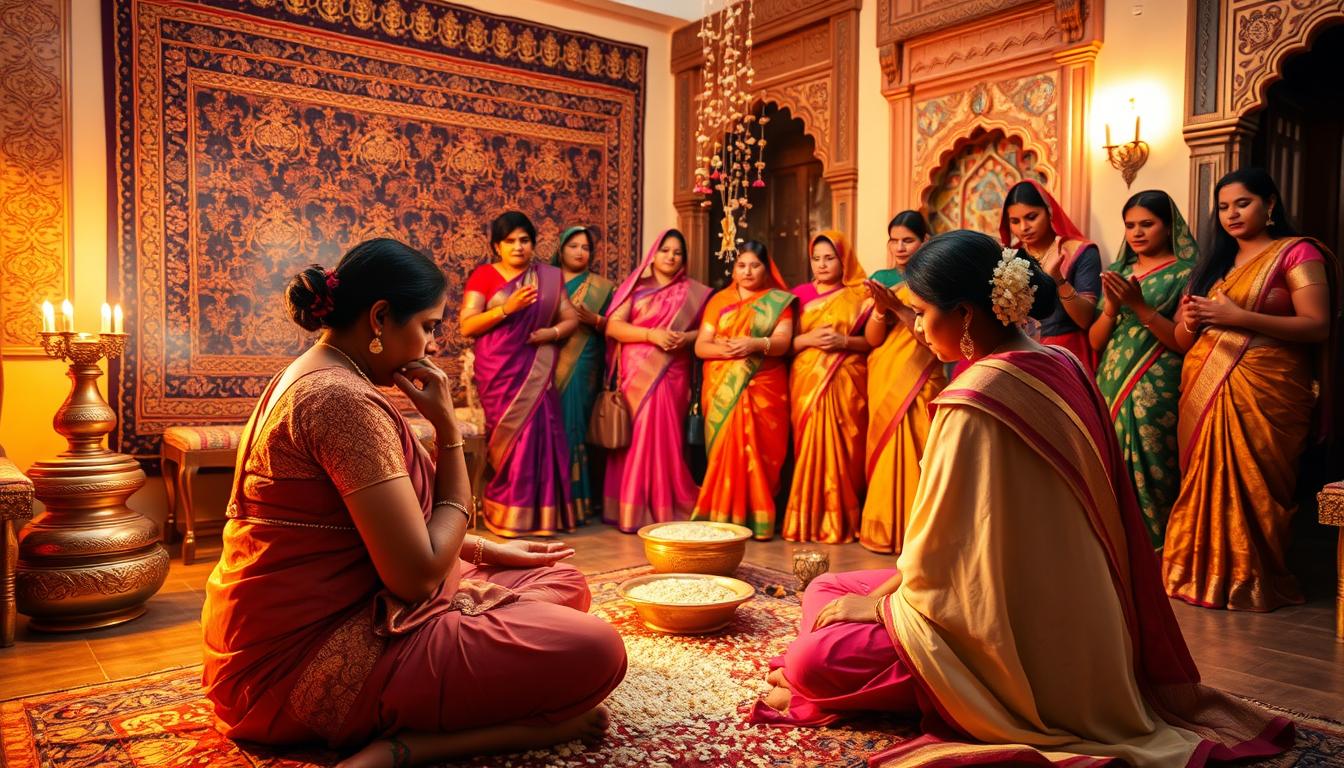
The Ganesh Pooja marks the commencement of the wedding festivities; it’s a ceremony where Lord Ganesh is invoked to eliminate all obstacles and bring good fortune to the couple’s life together. This ritual underscores the importance of divine blessings in new beginnings, making it a quintessential aspect of Pre-wedding Marwari traditions.
Following the divine invocation is the Bhaat Nyotana. This tradition involves personally inviting close relatives to the wedding. It’s not just an invite; it’s a gesture that emphasizes the value of presence, making each guest feel like a crucial part of the familial bond. This invitation is often accompanied by gifts, symbolizing appreciation and respect.
| Ritual | Significance | Key Elements |
|---|---|---|
| Ganesh Pooja | Invoking blessings for a smooth and prosperous start | Idol of Lord Ganesh, Offerings, Prayers |
| Bhaat Nyotana | Strengthening family relations through personal invitations | Personal meetings, Gift exchange, Invitations |
These initial rituals of Pre-wedding Marwari traditions not only create a sacred atmosphere but also foster unity among family members, preparing everyone in spirit and mind for the grand wedding to follow. Embracing these rituals helps maintain the cultural heritage and ensures that the spiritual essence of the Marwari community is celebrated with each marriage.
Deeply Rooted Traditions: Bhaat Bharna & Myra
In our exploration of Marwari wedding traditions, the bhaat bharna ceremony stands out as a poignant representation of familial bonds and mutual respect. Integral to the ceremonial practices of Marwari weddings, it involves the exchange of gifts between the families of the bride and groom, symbolizing the interweaving of their familial threads. This gesture is not merely about gift-giving but is deeply symbolic of the acceptance and welcoming of new family ties.
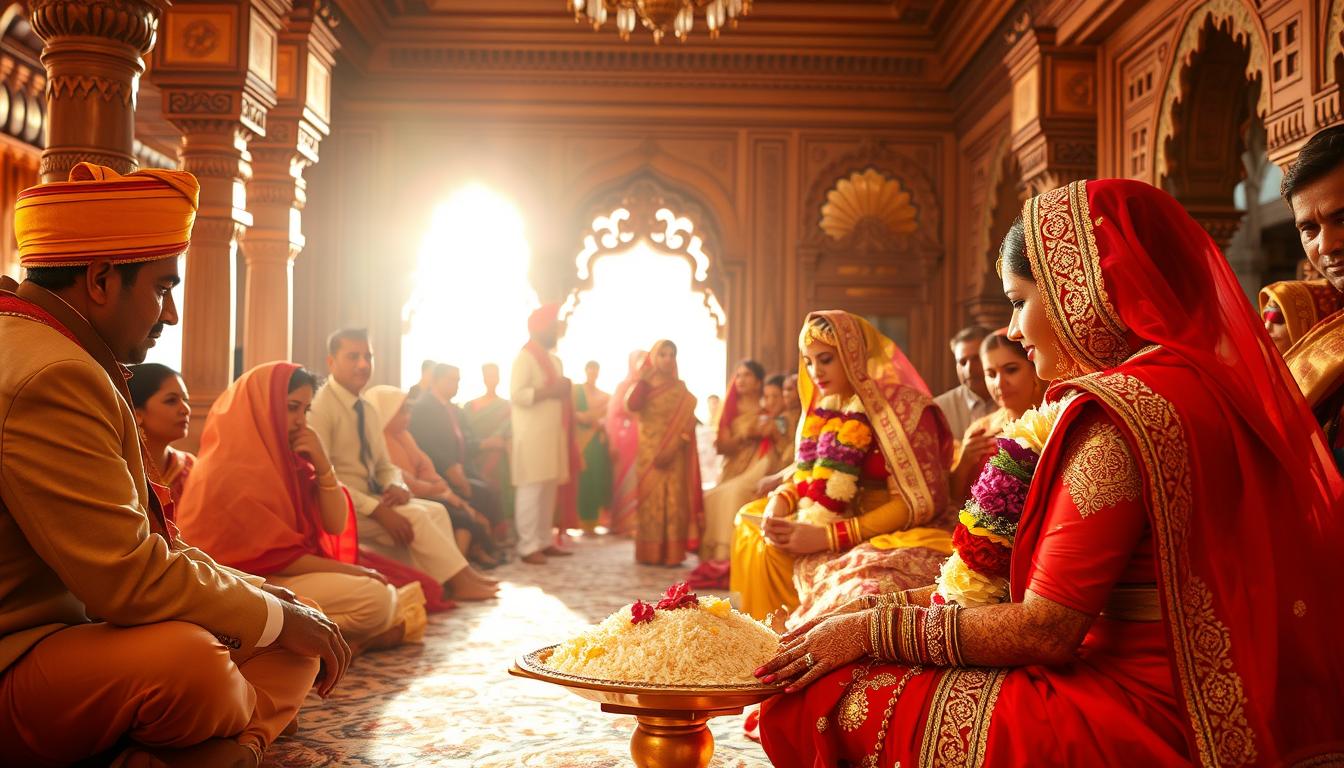
Following the bhaat bharna ceremony, the Myra event further encapsulates the generosity and affection characteristic of Marwari families. During Myra, the maternal uncles play a significant role, showering the bride and groom with lavish gifts. This act is more than traditional obligation; it is a heartfelt demonstration of the uncles’ support and joy for their niece or nephew’s new journey in life. It’s these elements that make Marwari weddings not just celebrations of marriage but also festivals of familial love and unity.
Understanding these traditions is vital for anyone interested in the cultural fabric of Marwari society. Each element, from the elaborate bhaat bharna ceremony to the affectionate Myra, is imbued with historical significance and communal values, offering a window into the rich cultural tapestry that Marwari weddings weave.
Festivities Unfold: Mehndi Ceremony and Mudda Tikka
Continuing our enchanting journey through Marwari pre-wedding rituals, we delve into two vibrant ceremonies that showcase the rich cultural tapestry of Marwari traditions. Let’s explore the beautiful Mehndi ceremony followed by the profound significance of the Mudda Tikka ceremony.
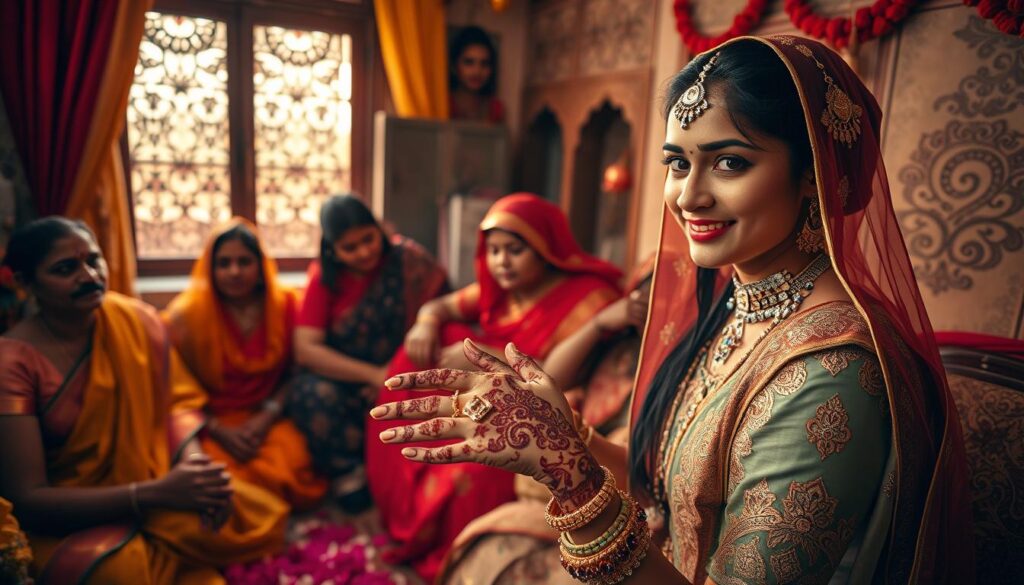
Mehndi, a traditional pre-wedding ritual, is renowned for its festive air and artistic flair. This ceremony primarily involves the application of henna on the hands and feet of the bride and often, the female members of the family. Marwari mehndi designs are celebrated for their intricate patterns and details which are believed to symbolize beauty, joy, spiritual awakening, and offering.
The Mudda Tikka ceremony, commonly known as Sagai, marks the formal engagement of the couple. It is a poignant moment in Marwari weddings where rings are exchanged, and the families of both the bride and groom unite to bless the union. The ceremony is steeped in customs that are a legacy of Marwari ancestors, fostering a sense of community and lasting bonds among the attendees.
| Ceremony | Significance | Key Elements |
|---|---|---|
| Mehndi | Symbolizes joy and transformation | Intricate henna designs on hands and feet |
| Mudda Tikka (Sagai) | Represents formal engagement and family blessings | Exchange of rings and ancestral customs |
The charm and depth of these ceremonies are a true reflection of the Marwari cultural heritage, intertwining ancient customs with the joyous celebration of upcoming nuptials. Exploring these rituals allows us to appreciate the continuity and respect for tradition that characterizes Marwari weddings.
A Night of Celebration: Mehfil, Telbaan, and Pitthi Dastoor
As the sun sets, the vibrant evening of a Marwari wedding begins, marked by the melodious sounds of a marwari musical celebration. This part of the Marwari wedding traditions guide enlightens us about the joyful event known as ‘Mehfil’, as well as the significant ‘Telbaan’ ritual and ‘Pitthi Dastoor’, preparing the bride and groom for their grand day.
Mehfil: Musical Celebrations
The Mehfil night is an essential facet of Marwari weddings, filled with music, dance, and laughter. Families unite to perform traditional songs and showcase classical dances that resonate with the cultural heritage of the Marwari community. This enchanting gathering is not just a display of artistic talents but also a crucial bonding time for the two families.
Telbaan and Pitthi Dastoor: Preparing the Bride and Groom
The Telbaan ritual and the Pitthi Dastoor are ceremonies steeped in symbolism and beauty. During the Telbaan, both the bride and groom are anointed with holy oils, which are believed to purify and beautify them. Following this, the ‘Pitthi Dastoor’ involves application of a turmeric paste, known for its auspicious properties, symbolizing a blessing for the couple’s new life ahead.
| Ritual | Purpose | Significance |
|---|---|---|
| Telbaan | Anointing with oils | Purification and beautification of the bride and groom |
| Pitthi Dastoor | Application of turmeric paste | Blessing for good health and prosperity |

Marwari Wedding Day Ceremonies
For those enchanted by vibrant cultural traditions, the Marwari wedding ceremony captures the essence of celebration and ritual. As the wedding day dawns, families and guests alike anticipate the sequence of rituals that lay the foundation for a joyous union. At the core these celebrations is the dazzling spectacle known as the marwari baraat ritual.
Nikasi: As the morning light spills, the groom embarks on his Nikasi – a traditional procession where he is adorned in all his princely regalia, ready to meet his bride. Accompanied by the joyful beats of the dhol and shehnai, the groom, often riding a decorated horse, becomes the centerpiece of this spectacular procession.
Baraat: Following Nikasi, the groom’s procession evolves into the electrifying Baraat. This procession is a lively affair, featuring dancing, singing, and the collective merriment of all who join. The Baraat is not just a journey; it’s a vibrant celebration of the groom’s happiness, brought to life by friends and family who dance their way to the wedding venue.
Toran: Upon arrival at the bride’s home or the venue, the groom is greeted by the bride’s family at the Toran, a ritualistic doorway adorned with flowers and auspicious symbols. Here, rituals of welcome are performed, symbolizing the groom’s entry into a new phase of life and into the bride’s family.

Each of these elements – Nikasi, Baraat, and Toran – interweave to form the rich tapestry of the Marwari wedding day, setting an exuberant tone for the sacred rites that follow. Captured within these moments are the traditions handed down through generations, each adding depth and color to the Marwari matrimonial landscape.
Heart of the Marwari Wedding: Jaimala and Kanyadaan
At the core of Marwari wedding customs, we encounter two highly symbolic rituals that signify the union of not just the bride and groom, but their families too. The exchange of garlands during the Jaimala ceremony and the sentimental Kanyadaan tradition represent deep-rooted cultural values cherished throughout generations.
Diving deeper into these rituals, Jaimala marks the beginning of the wedding ceremonies on the actual day, where the bride and groom place beautifully crafted garlands around each other’s necks. This act symbolizes their mutual acceptance and respect and is often met with joyous celebration from the attendees. Following this vibrant exchange, the atmosphere grows more solemn as the Kanyadaan begins.
The Kanyadaan tradition is perhaps one of the most heartfelt moments of a Marwari wedding, wherein the bride’s father entrusts his daughter to the groom, symbolizing the giving away of his most cherished gift. It is a poignant testament to the trust and bond between the two families and underscores the responsibility now shared by the groom to care for his wife.
These customs not only enrich the Marwari wedding experience but also serve to reinforce the familial bonds and cultural heritage that are integral to these celebrations. By participating in the Jaimala and observing the Kanyadaan, family, friends, and guests are reminded of the profound emotional and cultural significance these traditions hold within the Marwari community.
The Circle of Unity: Saptapadi or Phera
At the heart of marwari marriage traditions, the Saptapadi ceremony symbolizes a pivotal moment where the bride and groom walk around the sacred fire, taking seven steps that each vow lifelong commitment and understanding. This ritual, central in Marwari weddings, showcases the unification of two souls destined to support and love each other through life’s journey. Each step around the fire ignites a promise, from nourishing one another to upholding respect and care.
Understanding the significance of these steps helps us appreciate the depth of Marwari matrimonial rites. The couple circulates the fire which is considered a witness to their vows, binding them in an eternal bond that transcends mere legal or social agreements. This is not just about following tradition; it’s about a conscious choice to walk together, facing whatever lies ahead with mutual strength. Thus, the Saptapadi ceremony is not only a ritualistic formality but a profound establishment of a relationship built on the foundations of mutual respect, love, and spirituality.
We observe in these moments a beautiful blend of ancient customs and contemporary relevance, where each step ensures the couple’s dedication to live harmoniously and pursue their goals together. It is a sight of pure devotion and a testament to the sanctity and the enduring nature of marwari marriage traditions.
Sealing the Bond: Sindoor Daan and Vidaai
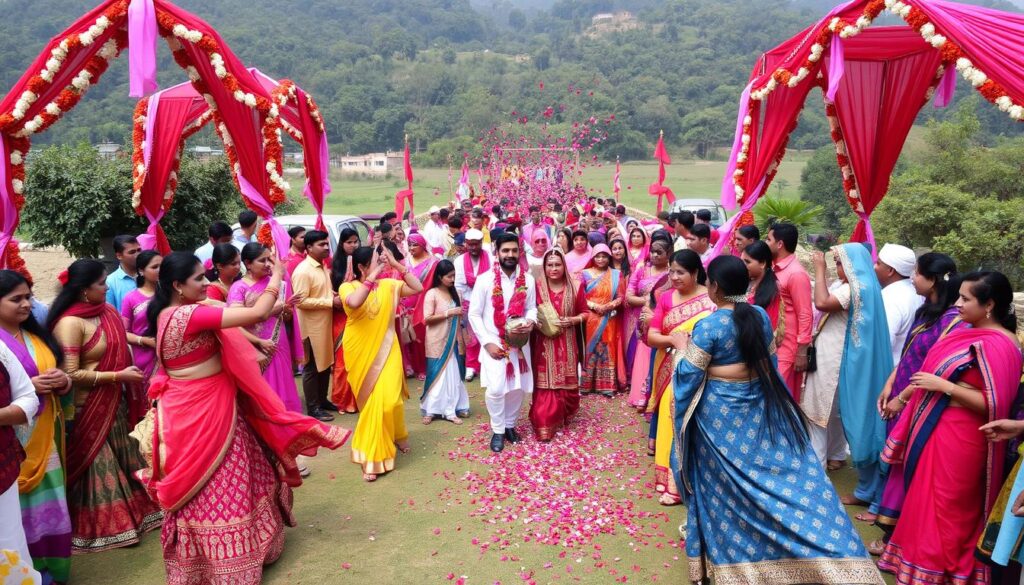
In the heart of Marwari wedding traditions, Sindoor Daan carries profound significance, marking the culmination of the wedding rituals and solidifying the marital bond. This ritual, where the groom applies vermilion to the bride’s parting, is a symbolic affirmation of their lifelong commitment and love. Let’s explore why this moment is so poignant and pivotal in a Marwari wedding.
The Sindoordaan’s importance extends beyond mere tradition; it is a sacred symbol of a woman’s marital status and the love and respect bestowed upon her by her husband. This act is not just a ritualistic formality but a profound declaration of the union, witnessed by family and deities alike.
| Aspect | Details |
|---|---|
| Symbolism in Sindoor Daan | Represents the groom’s commitment and protection towards his wife |
| Cultural Importance | Signifies the bride’s transition into her new marital life |
| Spiritual Relevance | Considered a blessing from the goddess Parvati for a long and prosperous married life |
Continuing from the emotional highs of Sindoor Daan, the ceremony of Vidaai marks another cornerstone of the wedding proceedings. It is during Vidaai that the bride bids a tearful farewell to her parental home, stepping into her new life with her spouse. Reflecting on both, these rituals not only signify the union of two souls but also the passage of care and responsibility from the bride’s family to the groom’s.
Embracing New Beginnings: Pag Phera
The pag phera tradition forms an essential part of the Marwari post-wedding rituals. This poignant ceremony symbolizes the bride’s return to her parental home after the wedding, reinforcing her bonds with her birth family even as she assumes new roles in her marital household. We delve into why this tradition holds significant cultural value and how it beautifully blends respect for origins with the embracing of new beginnings.

Understanding the pag phera tradition provides a deeper insight into Marwari cultural dynamics. Generally, it occurs one to three days post-wedding. The bride and groom visit the bride’s parental home where she is received with warmth and affection. This visit is not only a gesture of respect towards the bride’s family but also reinforces familial ties.
During this visit, the bride’s parents often prepare a meal, and there are exchanges of gifts, symbolizing the sharing of joy and the continuation of family ties despite the bride’s new marital responsibilities. The ceremony concludes with the bride and groom returning to their marital home, symbolically reiterating that while the bride has a new life and responsibilities, the connection to her roots remains unyielding.
We cherish the Marwari post-wedding rituals for the depth they add to the celebration of marriage, blending the old with the new in seamless harmony. The pag phera is more than just a ritual; it’s a reaffirmation of love, respect, and family values that are central to Marwari culture.
Conclusion
As we conclude our immersive journey through A Guide to Marwari Wedding Rituals & Traditions, it’s evident that each ceremony we’ve explored is a thread intricately woven into the vibrant fabric of Marwari culture. From the initial Roka to the heartfelt Vidaai, our guide has aimed to provide a window into the profound respect Marwari traditions hold for family ties, societal bonds, and the ceremonial splendor that characterizes these grand matrimonial festivities. Marwari wedding rituals explained within these pages are not just practices but a manifestation of an enduring legacy.
The myriad of pre-wedding, wedding, and post-wedding customs underscore the complexity and beauty of Marwari matrimonial celebrations. Through our extensive review of the rituals and their significance, we hope to have offered readers ample insights into the profound symbolism and deep-seated cultural values that each rite embodies. Whether it be the colorful Mehndi, the solemn Kanyadaan, or the celebratory Jaimala, anyone engaging with our guide to Marwari wedding rituals traditions would come away with a comprehensive understanding of this magnificent cultural tapestry.
In offering this guide, we’ve not only detailed the rituals but also celebrated the spirits behind them. For those who are newly initiating themselves into the folds of Marwari matrimonial culture, may this serve as an insightful and reliable companion. And for all our readers, we trust that this has illuminated the rich heritage and the elaborate customs that make a Marwari wedding a unique and unforgettable experience.
FAQ
What is the cultural significance of Marwari weddings?
Marwari weddings are a vibrant celebration of tradition, family bonds, and communal ties deeply rooted in Indian cultural heritage. These ceremonies not only signify the union of two individuals but also honor the rich Marwari customs passed down through generations.
What are the typical pre-wedding rituals in a Marwari wedding?
Pre-wedding rituals include a mix of engagements and poojas such as the Roka (formal engagement), Byah Haath (welcoming the bride), Naandi Ganesh Pooja (seeking divine blessings), and Mehndi (applying intricate henna designs), among others, each with its unique significance and role in the nuptial ceremonies.
How do Marwari weddings incorporate spiritual elements?
Spiritual elements are prominent in Marwari weddings through rituals like the Ganesh Pooja and Bhaat Nyotana. These traditions are designed to invite divine blessings, ensure an auspicious start, and emphasize the importance of family and religious values in the ceremony.
What is the ‘Bhaat Bharna’ ritual all about?
The Bhaat Bharna is a ceremony of gift-giving in which the families of the bride and groom present each other with gifts. This act exemplifies generosity and solidifies the newly formed familial alliance between the two households.
Can you explain the engagement ceremony in Marwari weddings?
The engagement ceremony, known as Mudda Tikka or Sagai, is when the bride and groom exchange rings, marking a formal pledge of marriage. Families celebrate this union with the exchange of gifts and blessings, affirming their commitment to the upcoming wedding.
What is the significance of the Mehfil, Telbaan, and Pitthi Dastoor in Marwari weddings?
Mehfil is an evening filled with music and dance, adding a festive spirit to the occasion. Meanwhile, Telbaan and Pitthi Dastoor are ceremonies where the bride and groom are anointed with oils and turmeric paste, symbolizing a purification process and preparing them for the wedding day.
What happens during the Marwari wedding day procession?
The wedding day procession starts with Nikasi, as the groom, decked out in finery, proceeds to the bride’s place. It’s followed by the Baraat, a lively introduction of the groom’s side to the wedding venue, and culminates with the Toran, welcoming the groom at the bride’s threshold.
Could you describe the Jaimala and Kanyadaan ceremonies?
Jaimala is the exchange of floral garlands between the bride and groom, symbolizing their acceptance of one another. Kanyadaan follows, a poignant moment where the bride’s father gives his daughter away to the groom, entrusting him with her care and symbolizing the family’s blessing on their union.
What is the Saptapadi or Phera ritual?
Saptapadi or Phera is a key ceremony where the couple takes seven rounds around the sacred fire, each round representing a vow of commitment and partnership. This ritual binds the couple together, marking their steps toward a shared future.
What happens during Sindoor Daan and Vidaai?
In Sindoor Daan, the groom applies vermilion to the bride’s hair parting, signifying that she is now a married woman. The Vidaai is a bittersweet farewell event where the bride departs from her parental home to begin a new life with her spouse, accompanied by meaningful rituals that reflect this significant transition.
What is the Pag Phera tradition in Marwari weddings?
Pag Phera is a heartwarming ritual, post-wedding, where the bride revisits her parental home. It’s a beautiful tradition that acknowledges her continuing bond with her birth family while she embraces her new life and responsibilities.



Thanks for posting. I really enjoyed reading it, especially because it addressed my problem. http://www.kayswell.com It helped me a lot and I hope it will help others too.